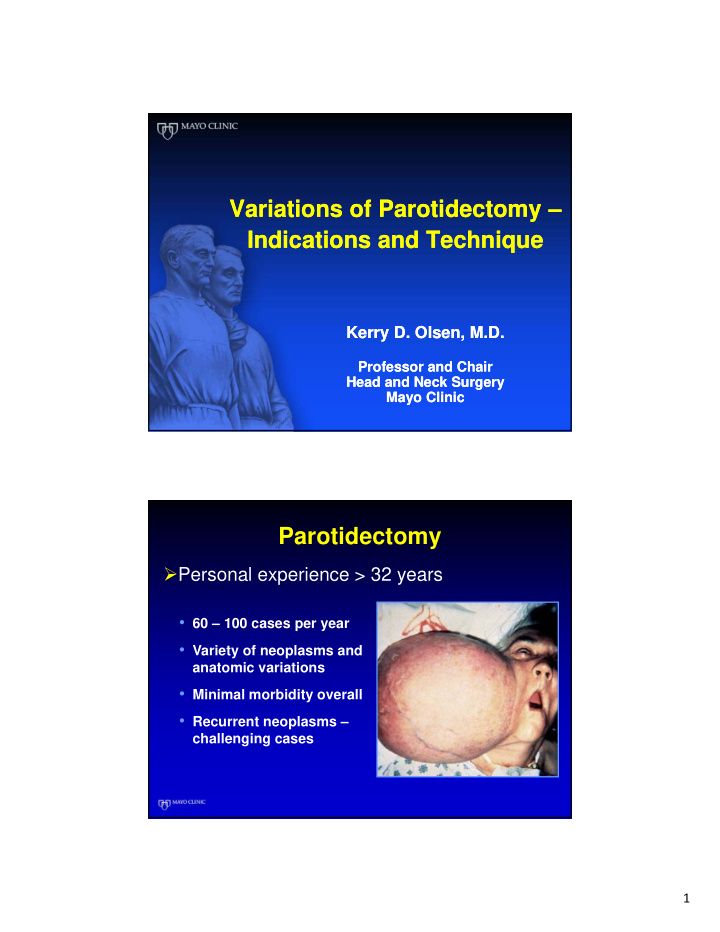



Variations of Parotidectomy – Variations of Parotidectomy – Indications and Technique Indications and Technique Kerry D. Olsen, M.D. Kerry D. Olsen, M.D. Professor and Chair Professor and Chair Head and Neck Surgery Head and Neck Surgery Mayo Clinic Mayo Clinic Parotidectomy Personal experience > 32 years • 60 – 100 cases per year • Variety of neoplasms and anatomic variations • Minimal morbidity overall • Recurrent neoplasms – challenging cases 1
Parotid Surgery - Challenges Patient expectations Variety of tumors encountered Relationship and size of the tumor to the nerve Extend the operation as needed Role of pathology Parotidectomy Surgical options: • Superficial parotidectomy • Partial parotidectomy • Deep lobe parotidectomy • Total parotidectomy • Extended parotidectomy 4 2
Surgical Technique Superficial parotidectomy Deep lobe parotidectomy Surgeons will spend their entire career trying to learn when it is safe or necessary to do more or less than a superficial parotidectomy 5 Superficial Parotidectomy Indications • Neoplasm • Risk of metastasis • Recurrent infection/abscess • Surgical exposure – deep lobe/ parapharynx/ infratemporal fossa • Cosmesis 6 3
Pre-operative Discussion Individualized • Goals – rational – risks Goals – safe and complete removal with surrounding margin of normal tissue and preservation of facial nerve function 7 8 4
9 10 5
11 12 6
13 14 7
Facial Nerve Identification Helpful: • Cartilaginous pointer • Posterior belly of the digastric muscle • Mastoid tip Retrograde dissection Mastoid dissection 15 16 8
17 18 9
19 20 10
Superficial Parotidectomy Surgical goals • Avoid facial nerve injury • Remove tumor with surrounding parotid tissue • Minimize capsular dissection • Avoid tumor spillage 21 Partial Parotidectomy Inferior parotidectomy Posterior parotidectomy Accessory parotidectomy Deep lobe partial parotidectomy 22 11
23 24 12
Deep Lobe of the Parotid Gland Largest portion between ramus of mandible and mastoid process Small amount deep to facial nerve and over masseter muscle Smaller extension retromandibular into the parapharyngeal space 25 Deep Lobe Parotidectomy Indications To understand the indications one must know: • Regional anatomy • Embryology • Lymphatic drainage of the parotid area • Parotid tumor behavior • Effective surgical technique 26 13
Parotid Lymph Nodes Parotid Lymph Nodes 15-20 parotid regional nodes 15-20 parotid regional nodes Paraglandular – intraglandular Paraglandular – intraglandular Number lymph Number lymph nodes nodes superficial superficial lobe > number lobe > number lymph nodes lymph nodes deep lobe deep lobe 27 Parotid Lymph Nodes Parotid Lymph Nodes Mean ± SD Mean ± SD Range Range Superficial lobe Superficial lobe 7.6±3.4 7.6±3.4 3-19 3-19 Deep lobe Deep lobe 2.3±1.8 2.3±1.8 0-9 0-9 28 14
Deep Lobe Parotidectomy Indications Both benign and malignant tumors • Deep lobe parotidectomy alone – usually benign disease • For malignant disease – deep lobe parotidectomy generally done in conjunction with a superficial parotidectomy Facial nerve preserved or removed depending on the individual case 29 Deep Lobe Parotid Surgery Partial Removal Identification of facial nerve portion or all Mobilization of facial nerve Removal portion gland by tumor Preservation most deep structures 30 15
31 32 16
33 34 17
35 Deep Lobe Removal Total Parotidectomy Concept lymphatic spread • Primary parotid neoplasms • Metastasis to superficial parotid nodes Frequently misunderstood aspect of the treatment of parotid malignancy 36 18
Case Report Melanoma temple with palpable mass lower pole of parotid PET scan / CT negative except for single parotid node 37 Case Report Treatment Treatment • Excision of the primary • Excision of the primary • Superficial parotidectomy • Superficial parotidectomy One 2 x 2 cm node pos. One 2 x 2 cm node pos. 1 / 6 other nodes 1 / 6 other nodes positive positive • Deep lobe removed • Deep lobe removed 1 / 3 nodes positive 1 / 3 nodes positive • Select neck dissection • Select neck dissection 1 / 8 upper nodes 1 / 8 upper nodes positive positive 0 / 10 mid 0 / 10 mid 0 / 6 low 0 / 6 low 38 19
Deep Lobe Removal Positive Superficial Parotid Nodes 66 year old male Parotid gland adenocarcinoma Pathology findings • 8 of 9 superficial parotid nodes positive • 5 of 6 deep lobe nodes positive • 15 of 41 neck nodes positive 39 Deep Lobe Removal High Grade Parotid Malignancy 64 year old male Carcinoma Ex-pleomorphic – superficial lobe Sarcomatoid salivary duct carcinoma type Pathology findings • 3x3x2 cm parotid mass – sup. lobe • 4 parotid nodes negative • 42 neck nodes negative • 2 deep lobe nodes positive 40 20
Deep Lobe Parotidectomy Indications Actual or presumed metastasis to deep parotid nodes • All cases of metastasis to superficial parotid nodes (Parotid and extra- parotid primaries) • Any parotid malignancy with cervical metastasis • High grade aggressive parotid malignancies 41 Deep Lobe Parotid Surgery Deep Lobe Parotid Surgery Total Removal Total Removal Initial superficial parotidectomy Initial superficial parotidectomy Complete facial nerve mobilization Complete facial nerve mobilization Removal vessels – key step! Removal vessels – key step! • External carotid • External carotid • Superficial • Superficial temporal temporal • Internal • Internal maxillary maxillary 42 21
43 44 22
45 46 23
47 48 24
49 50 25
51 Deep Lobe Parotidectomy Deep Lobe Parotidectomy En-bloc removal En-bloc removal Preserve facial nerve Preserve facial nerve Remove gland and deep parotid Remove gland and deep parotid nodes nodes Safe and effective Safe and effective 52 26
53 54 27
55 56 28
57 58 29
59 60 30
61 62 31
63 64 32
Summary Surgeon should be able to match patient’s expectations of a safe successful tumor removal with preservation of facial nerve function Challenges – unknowns – unexpected – unusual 65 33
Recommend
More recommend